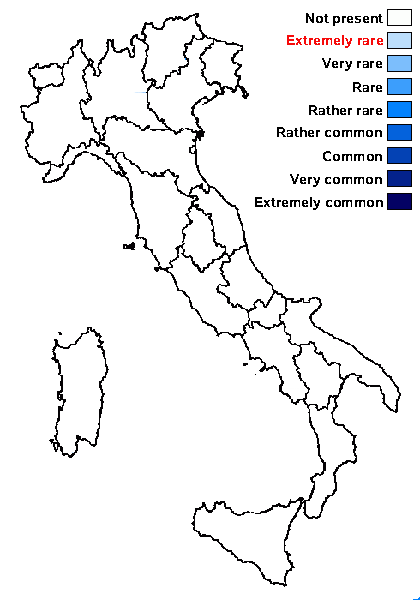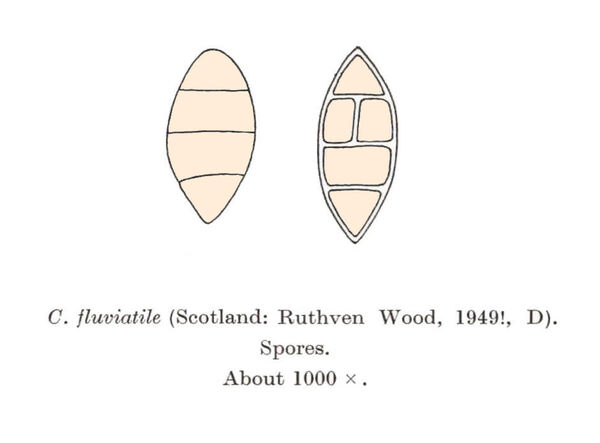Lathagrium dichotomum (With.) Otálora, P.M. Jørg. & Wedin
Fungal Diversity, 64, 1: 287, 2013. Basionym: Tremella dichotoma With. - Bot. Arr. Veg. Gr. Brit., 2: 733, 1776
Synonyms: Collema cataclystum Körb.; Collema dichotomum (With.) Coppins & J.R. Laundon; Collema fluviale (Huds.) Ach.; Collema fluviatile (Huds.) Steud. ex Ach.; Leptogium fluviatile (Huds.) Leight.
Distribution:
Description: Thallus foliose, homoiomerous, up to 2.5 cm wide when dry (larger when moist), often forming orbicular rosettes, bright green, olive-green to brown-green. Lobes c. 0.5-1.5(-4) mm broad, 170-430 µm thick when moist, often ascending, repeatedly forked, strap-like, fan-shaped at the ends, without isidioid outgrowths, loosely attached by rounded hapters or crowded rhizines. Upper and lower cortices absent. Apothecia usually rare, lecanorine, sessile and constricted at base, 0.7-1 mm across, with a flat, brown disc and a thin, entire, smooth thalline margin. Proper exciple thick, euparaplectenchymatous, the cells 8-20 µm wide; epithecium yellowish to reddish brown; hymenium colourless, c. 150 µm high, I+ blue; paraphyses simple or sparingly branched in upper part, the apical cells up to 5 µm wide; hypothecium colourless to pale yellow. Asci (6-)8-spored, cylindrical-clavate, the apex strongly thickened, the apical dome K/I+ pale blue, with a downwardly projecting K/I+ deep blue tubular structure. Ascospores 3-septate to submuriform (with a single longitudinal septum), hyaline, ellipsoid, 20-30 x 8.5-13 µm. Pycnidia rather frequent, characteristically large, c. 0.3-0.6 mm across, superficial, reddish yellow with a blackened apex, appearing as swollen, low tubercles with a prominent opening. Conidia simple, bacilliform, 5-6.5(-8) x 1.2-1.5 µm. Photobiont cyanobacterial, (Nostoc, the cells in short chains). Spot tests: all negative. Chemistry: without lichen substances.Note: a widespread, but very rare species growing on permanently inundated siliceous rocks in clear, cold mountain streams, also in the splash zone, but rarely drying out. Known also from a very few stations in the Alps, outside Italian territory. To be looked for in the Italian Alps.
Growth form: Foliose
Substrata: rocks
Photobiont: cyanobacteria, filamentous (e.g. Nostoc, Scytonema)
Reproductive strategy: mainly sexual
Periodically submerged (e.g. in creeks)

Predictive model
Herbarium samples
Growth form: Foliose
Substrata: rocks
Photobiont: cyanobacteria, filamentous (e.g. Nostoc, Scytonema)
Reproductive strategy: mainly sexual
Periodically submerged (e.g. in creeks)

Predictive model
| Herbarium samples |



